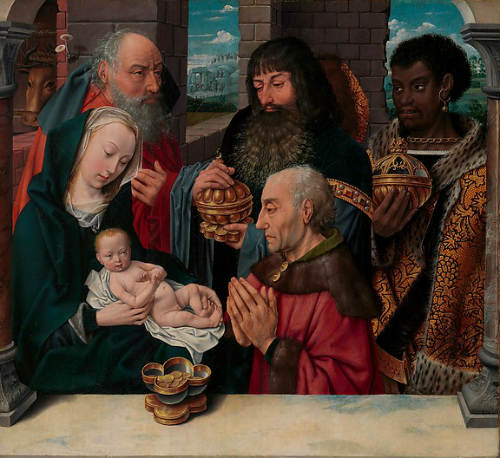Search:: Artists Alphabetically Artists by Country Artists by Century Artists by Movement
Flemish Northern Renaissance Spiritual Painting

The Adoration of the Magi by Copy after Hugo van der Goes
Art
has always been integral to Christianity. Sacred paintings and sacred
symbolism aid in connecting the believer with the spiritual realm.
Author Gustavus George asserts "Into a spiritual
world, in which our intellect moved, as it were, in a
circle. We took our beginning in the infinite, lost our transitory
bodily form, and returned to the infinite from which we emanated—a kind
of idealisation of the corporeal. A world of external forms,
which in their individual phenomena had only a meaning as the fragile
temporary vessels of the eternal Spirit; this Spirit was no longer a
universal sum total by which the individual was hereafter absorbed, but
was assumed to remain individualised through all eternity. Artists and
men worked not only for this world, but their deeds were to outlast all
time to come "
Important Words, People, Phrases, Characteristics related to the Northern Renaissance Art Movement - allegorical painting, rebirth, invention of oil painting, Hieronymus Bosch, Limbourg Brothers, Desiderius Erasmus, Robert Campin, Jan Van Eyck, Jean Fouquet, Albrecht Dürer, Johannes Gutenberg, Johann Reuchlin, Martin Luther, rise of the merchant class, world landscape, Low Countries, Protestant Reformation, Calvinisim, glazing, impasto, scriptorium, illuminator, invention of the printing press, woodcuts, engravings, Antwerp School, Guild of Saint Luke, commerce, Flemish School, Northern Europe, Antwerp School, Flanders, Bruges, renewed interest in classical learning, mythological scenes, genre painting, landscapes, portraits, moralizing overtones, human vices, lust, paradise, spirituality, piousness, living a simple life, reform, Human Reasoning, tradesmen at work, idyllic scenes of peasants, playing games, feasting, linear perspective, \Heliocentric Theory, humour, satire, spiritually significant, illuminated manuscript, idealized biblical themes, scriptorium, emotion, illuminator, iconoclast, Age of Discovery, Virgin and Child, axonometric drawing, curiosity about the natural world, realistic use of colours and light, Old Testament stories, Gospel parables, The Blackdeath, Christian symbolism
☼☼☼☼☼
© HistoryofPainters.com If you like this page and wish to share it, you are welcome to link to it, with our thanks. updated 3/25/2017